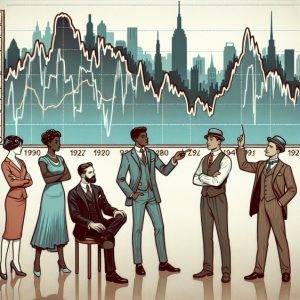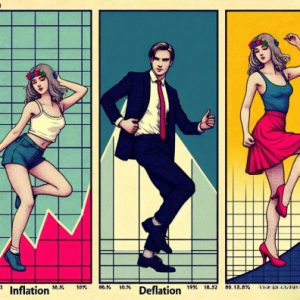
What Is Stock Market Psychology: Strategies for Long-Term Success
Updated March 31, 2024
Introduction: What Is Stock Market Psycholog?
The psychology of a market cycle is an engaging exploration of the emotional and cognitive influences affecting investors’ decisions during various market stages. It recognizes that market movements are driven by participants’ emotions, providing a unique perspective on market analysis. This understanding can help predict market trends, navigate volatility, manage risk, and enhance profitability. Investors can make strategic decisions that align with their goals by examining the emotional shifts from optimism during a boom to fear during a downturn. Ultimately, understanding the psychology of a market cycle is an invaluable tool for any investor.
Market Cycle Psychology: The Pendulum of Emotions
The market psychology cycle unpacks the emotional journey investors undergo during different stages in the market cycle. Each stage features distinct emotions influencing investors’ decisions, from disbelief to thrill. By understanding these stages, investors can better interpret market trends, navigate challenges, and seize opportunities, ultimately making more strategic investment decisions. Historical instances like the 2008 financial crisis and the dot-com bubble underline the significant impact of market psychology.
Disbelief in the Market Psychology Cycle
The disbelief stage is a critical part of the market psychology cycle. This phase typically occurs after the market has hit rock bottom and begins to show signs of recovery. Still reeling from the recent downturn, investors are sceptical about the potential for a sustained rally. They may be hesitant to invest or trade as they do not believe that the market has the potential to improve. This disbelief is often rooted in the memory of recent losses, leading to a cautious approach to any signs of recovery. Despite the market showing positive signs, investors may hold back, expecting the markets to fall again just like they did in the past few months.
An example of this disbelief stage can be seen in the aftermath of the 2008 financial crisis. After the market crash, there was a period of recovery where the market started to show signs of improvement. However, many investors were sceptical about this recovery. They had experienced significant losses during the crash and were wary of another potential downturn. This scepticism led many investors to hold back from investing despite the positive signs in the market. This is a classic example of the disbelief stage in the market psychology cycle.
Understanding this stage can help investors make more informed decisions and avoid common pitfalls. For instance, investors might miss out on opportunities during disbelief due to their scepticism and caution. On the other hand, this stage can also protect investors from jumping back into the market too quickly and potentially experiencing further losses.
Hope in the Market Psychology Cycle
The hope stage is a pivotal point in the market psychology cycle. This phase typically follows the disbelief stage and is characterized by a shift in investor sentiment from scepticism to cautious optimism. As market conditions improve, investors start to entertain the possibility of a price recovery from the lows. There’s a growing belief that the upward movement will hold, signalling the start of a potential bull market.
An example of the hope stage can be seen in the early stages of the recovery from the 2008 financial crisis. After a prolonged market downturn, the first signs of economic recovery emerged in 2009. The U.S. Federal Reserve’s decision to lower interest rates and implement quantitative easing measures led to a gradual improvement in market conditions. Investors, who had been in disbelief due to the severity of the financial crisis, began to see a glimmer of hope. The possibility of a price recovery seemed plausible, and there was a growing belief that the upward movement in the market would hold.
Despite the positive signs, the hope stage is characterized by cautious optimism. Investors may see profit opportunities and become more willing to take risks. However, the scars from the previous downturn are still fresh. The memory of significant losses and the fear of another potential downturn can lead to a degree of caution. Investors may tread carefully, balancing their newfound hope with the lessons learned from the recent market crash.
The hope stage is a critical part of the market psychology cycle as it marks the transition from a bear market to a potential bull market. It’s a period of cautious optimism where investors regain confidence in the market. However, it’s also a stage where investors need to exercise caution. The hope of a market recovery can sometimes lead to overly optimistic investment decisions. Understanding the dynamics of the hope stage can help investors navigate this phase more effectively, balancing their optimism with a healthy dose of caution.
Optimism in the Market Psychology Cycle
The optimism stage is a significant phase in the market psychology cycle. It typically follows the hope stage and is characterized by a growing belief among investors that the price upswing is real and likely to continue. The market has been trending higher, and the positive sentiment is palpable. Investors may start to invest more heavily, buoyed by the positive market performance and the expectation of further gains.
A historical example of the optimism stage can be seen in the dot-com bubble of the late 1990s. During this period, the advent of the internet led to a surge in technology and internet-based companies. Investors were optimistic about the potential of these new technologies and the opportunities they presented. This optimism led to a significant influx of capital into the market, with investors seeking to take advantage of the upward trend.
However, as we now know, this optimism was misplaced. The dot-com bubble eventually burst, leading to significant losses for many investors. This example serves as a reminder of the potential risks associated with the optimism stage. While the positive sentiment and upward trend can present profit opportunities, they can also lead to overconfidence and irrational investment decisions.
The optimism stage of the market psychology cycle is characterized by increased confidence in the market’s trajectory. However, it’s also a stage where investors need to exercise caution. The optimism can sometimes lead to overly optimistic investment decisions, potentially resulting in significant losses. Understanding the dynamics of the optimism stage can help investors navigate this phase more effectively, balancing their optimism with a healthy dose of caution.
Belief in the Market Psychology Cycle
The belief stage is an essential phase in the market psychology cycle. This phase typically follows the optimism stage and is marked by solidifying confidence among investors. This is where market participants start to believe that the market will continue to improve. They may become more confident in their investment decisions and more willing to hold onto their positions for extended periods, anticipating further gains. This belief stage often triggers a surge in market activity, as the positive sentiment encourages more investors to enter the market.
One historical example of the belief stage was observed during the gold rush in the early 2000s. Gold prices were steadily climbing, and investors, seeing the upward trend, started to believe in the continued rise of gold’s value. This belief was fueled by various factors, including geopolitical tensions and the appeal of gold as a “safe haven” asset. As a result, more investors entered the gold market, and those already holding positions were reluctant to sell, expecting prices to climb even higher. This was a clear sign of a bull market in gold.
However, it’s important to remember that the belief stage, while characterized by a bullish sentiment, can also lead to potential pitfalls. For example, during this gold rush, some investors might have ignored the signs of overvaluation due to their strong belief in the market’s upward trajectory. When gold prices eventually corrected, those who bought in late or held onto their positions for too long likely suffered losses.
A strong belief in the market’s upward trend can lead to profitable investments, but it can also blur the signs of overvaluation or upcoming market corrections. Understanding this stage’s characteristics can help investors navigate it more effectively, making investment decisions that are not only based on belief but also on careful analysis of market conditions.
Navigating Stock Market Psychology: The Thrill of the Ride
High emotions and increased market activity characterize the thrill stage of the stock market psychology cycle. At this point, the market has been on an upward trend for some time, and investors are starting to see significant returns. The prospect of further gains can lead to a bullish sentiment, with people becoming more vocal about buying and a general excitement about the market.
However, as Warren Buffett wisely cautioned, “Be fearful when others are greedy.” The thrill of potential profits can sometimes lead to risky behaviour, such as over-investing or ignoring warning signs. Historical examples, like the Roaring Twenties, the British Railway Mania, the South Sea Bubble, and the California Gold Rush, demonstrate the potential pitfalls of the thrill stage.
During the 1920s, the U.S. stock market saw a prolonged period of rising prices, with investors thrilled by the prospect of easy money. This eventually led to the 1929 crash and the Great Depression, as excessive risk-taking and margin buying left many with significant losses.
Similarly, the British Railway Mania of the 1840s, fueled by the excitement of a revolutionary new industry, resulted in overvalued companies and substantial losses for investors when the bubble burst. The South Sea Bubble of the early 18th century and the California Gold Rush of the 1840s also exemplify the dangers of getting caught up in the thrill of potential wealth.
As John Templeton famously noted, “Bull markets are born on pessimism, grow on scepticism, mature on optimism, and die on euphoria.” Understanding the stock market psychology cycle and the thrill stage’s potential risks is crucial for navigating the market effectively. By remaining cautious and level-headed, even in the face of excitement and optimism, investors can make more informed decisions and potentially avoid the pitfalls associated with this cycle stage.
Conclusion
Emotions drive traders’ buying and selling, which moves prices. That movement then impacts traders’ perception of the market, altering their emotional state and becoming more optimistic. This, in turn, affects where and when they decide to buy and sell in the future, influencing price movement. That is how the market operates – it is one giant feedback loop!
Understanding the psychology behind these cycles isn’t just about managing numbers and trends; it’s more about managing emotions and expectations. It’s crucial to recognize that markets move in cycles, each with distinct characteristics and psychological impacts. This understanding can help investors navigate the ups and downs of investing, make more informed decisions, and potentially realize more significant returns.
Beyond the Surface: Provocative Perspectives

Class in Capital Growth: Tactical Asset Allocation vs Strategic

Discover How the Extra Return Generated Through Stock Market Timing Strategies Should Be

Stock Market Fear Meter: All Bark, No Bite

Stock Market Forecast for Next Week: Ride the Thrilling Trend!

Rags to Riches Stories: The Power of Perseverance and Discipline

Dow Jones Average Chart: Trading for Success

Financial Disaster Recovery Plan: Buying the Crash, Selling the Joy

Inflation vs Deflation vs Disinflation: Navigating and Winning

Unmasking Deceit: Examples of Yellow Journalism

Crude Oil Crash: Unveiling Crowd Stupidity and Opportunity

Mass Psychology Overview: Unveiling its Enigmatic Dynamics

What is Mass Psychology: Mastering the Investment Game

Strategic vs Tactical Asset Allocation: The Dominating Difference

When Inflation is, the Fed Aims to Slow the Economy



